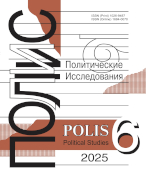Military Artificial Intelligence in the U.S. and PRC:
cooperate and don’t fight?
Pomozova N.B.,
Russian State University for the Humanities, Moscow, Russia, npomozova@mail.ru
elibrary_id: 1140071 | ORCID: 0000-0002-9981-0593 | RESEARCHER_ID: AAE-3313-2020
Litvak N.V.,
MGIMO University, Moscow, Russia, jourfr@mail.ru
elibrary_id: 655516 | ORCID: 0000-0003-1621-0005 |
Article received: 2024.11.14 13:59. Accepted: 2025.02.28 14:00

DOI: 10.17976/jpps/2025.03.02
EDN: ERUDSW
Pomozova N.B., Litvak N.V. Military Artificial Intelligence in the U.S. and PRC: cooperate and don’t fight?. – Polis. Political Studies. 2025. No. 3. https://doi.org/10.17976/jpps/2025.03.02. EDN: ERUDSW (In Russ.)
The rapid and so far unregulated development of artificial intelligence technologies in the last few years has created conditions for a new large-scale arms race of actors using military artificial intelligence. The USA, which constantly reaffirms its goal of maintaining global leadership and military superiority, now considers AI technologies a critical factor and, in this regard, is strengthening systemic restrictions on the access to them of its competitors, primarily China, which, together with Russia, is officially called a rival. In turn, China, which has been developing rapidly and comprehensively in the last two decades, has moved to a more active foreign policy, which would provide it with the necessary conditions at least not to lose in the growing confrontation. In its concepts, state and party documents, Beijing, unlike Washington, emphasizes maintaining peace, universal development and prosperity, while striving to achieve scientific and technological independence. However, a fairly long period of globalization has also given rise to close economic ties and, to a certain extent, scientific symbiosis between these powers. Therefore, now Washington will have to decide whether and at what cost, in the case of a break, it will be able to independently compete with the actors that have at least comparable competitive potential. The article provides a classification of types of military artificial intelligence and describes some aspects of the current confrontation between the United States and China in this area.
References
United States Department of the Army. (1979). FM 33-1 psychological operations. https://archive.org/details/FM33-1PsychologicalOperations/page/n7/mode/2up
Daly, A., Hagendorff, T., Li, H., Mann, M., Marda, V., Wagner, B., Wang, W., & Witteborn, S. (2019). Artificial intelligence, governance and ethics: global perspectives. The Chinese University of Hong Kong Faculty of Law Research Paper. http://dx.doi.org/10.2139/ssrn.3414805
Gillath, O., Ai, T., Branicky, M.S., Keshmiri, S., Davison, R.B., & Spaulding, R. (2021). Attachment and trust in artificial intelligence. Computers in Human Behavior, 115, 106607. https://doi.org/10.1016/j.chb.2020.106607
Kahn, L.A. (2024). Risky incrementalism. Defense AI in the United States. In The Very Long Game. 25 Case Studies on the Global State of Defense AI (pp. 39-61). Hamburg: Defense AI Observatory. https://doi.org/10.1007/978-3-031-58649-1_2
Lee, S. (2024) U.S.-China Technology competition and the emergence of techno-economic statecraft in East Asia: high technology and economic-security nexus. Journal of Chinese Political Science, 29, 397-416. https://doi.org/10.1007/s11366-023-09878-8
Lee, S., & Wiegand, K. (2025). South Korea’s strategy toward the US–China rivalry. Journal of East Asian Studies, 24(3), 305-323. https://doi.org/10.1017/jea.2024.7
Onnis, B. (2013). Has China plans for world domination? Comparative Civilizations Review, 68, 55-73. https://scholarsarchive.byu.edu/ccr/vol68/iss68/6
Rudin, C. (2019). Stop explaining black box machine learning models for high stakes decisions and use interpretable models instead. Nat Mach Intell, 1, 206-215. https://doi.org/10.1038/s42256-019-0048-x
Taddeo, M., McNeish, D., Blanchard, A., & Edgar, E. (2021). Ethical principles for artificial intelligence in national defence. Philos. Technol, 34, 1707-1729. https://doi.org/10.1007/s13347-021-00482-3
Velliet, M. (2025) From nonproliferation to strategic competition: US export controls and China. International Politics. https://doi.org/10.1057/s41311-024-00655-9
Danilin, I.V. (2021). The U.S.-China technological war through the prism of techno-nationalism. Pathways to Peace and Security, 1, 29-43. (In Russ.) https://doi.org/10.20542/2307-1494-2021-1-29-43
Pashentsev, E.N. (2017). Strategicheskaya kommunikatsiya i prognosticheskoe oruzhie [Strategic communication and predictive weapons]. In M.V. Granovskaya, O.A. Timakova (Eds.), Transformatsiya mezhdunarodnykh otnoshenii v XXI veke [Transformation of international relations in the 21st century] (pp. 255-262). Moscow: Diplomaticheskaya akademiya MID Rossii. (In Russ.)
Liu, Shengxiang, & Li, Zhihao. (2024). Trends and impact of Artificial intelligence in U.S. military strategy. International Perspective, 3, 51-73. Guoji zhanwang. (In Chin.) https://www.siis.org.cn/updates/cms/cms/202405/141111576tq2.pdf
Sun, Haiyong. (2022). The militarization of by the US: trends, risks and countermeasures. Guoji luntan, 2, 33-49. (In Chin.) https://www.doi.org/10.13549/j.cnki.cn11-3959/d.2022.02.002
Zhu, Rongsheng, & Chen, Qi. (2022). U.S. artificial intelligence policy towards China: power game or security driven. Peace and Development, 6, 47-70. (In Chin.)
See also:
Bogdanov K.V., Yevtodyeva M.G.,
Lethal autonomous weapon systems: landscape and perspectives. – Polis. Political Studies. 2022. No6
Baranovsky V.G.,
Basic parameters of modern system of international relations. Part III. – Polis. Political Studies. 2012. No5
Chugrov S.V.,
Moscow University Bulletin. Series 25. International relations and world politics: 5 years on track. – Polis. Political Studies. 2014. No5
Baranovsky V.G.,
Basic parameters of modern system of international relations. Part II. Qualitative parameters. – Polis. Political Studies. 2012. No4
Baranovsky V.G.,
Basic parameters of modern system of international relations (Part I). – Polis. Political Studies. 2012. No3




.jpg)






 print
print
.jpg)
.jpg)